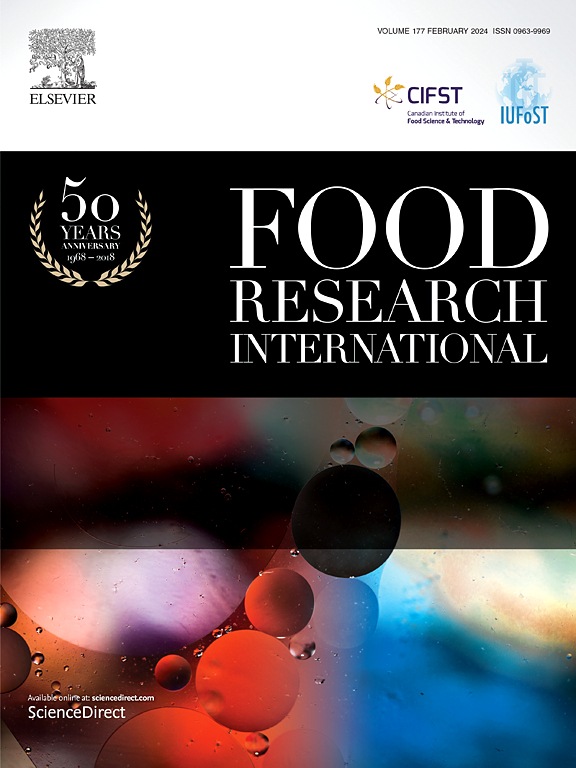Synthetic and natural microbial communities in high-temperature Daqu production: Insights into metabolic pathways and volatile organic compounds
IF 8
1区 农林科学
Q1 FOOD SCIENCE & TECHNOLOGY
引用次数: 0
Abstract
High-temperature Daqu (HTD), an essential fermentation starter in sauce-aroma Baijiu, is characterized by complex microbial communities that vary significantly across production regions. Traditional HTD production faces challenges in consistency and quality control, hindering industrial scalability. This study compared 54 synthetic microbial communities (SynMC)-fortified HTD samples with 39 traditional HTD samples from core production regions, which are Renhuai, Luzhou, and Jinsha, respectively, to elucidate their microbial and metabolic profiles. Physicochemical analysis revealed high similarity between fortified and traditional samples, while organic acid profiling demonstrated distinct regional patterns. Volatile organic compound (VOC) analysis identified 190 characteristic components across regional samples, with phenols and pyrazines dominating in Renhuai HTD, ketones in Luzhou samples, and esters in Jinsha HTD. Notably, certain SynMC samples (A14, A25, A13, and A34) closely replicated the VOC profiles of traditional HTD. Microbial community analysis revealed region-specific fungal and bacterial signatures, with SynMC samples successfully mimicking these patterns. Dominant fungi included Thermomyces, Thermoascus, and Monascus, while bacterial communities featured Kroppenstedtia, Thermoactinomyces, and Bacillus. Metabolic pathway analysis identified 72 shared pathways between corresponding SynMC and traditional HTD groups, including those involved in amino acid biosynthesis, central carbon metabolism, and energy production. Moreover, the study emphasizes the pivotal role of Bacillus as a key microorganism in driving metabolic function. These findings provide theoretical insights and practical strategies for optimizing HTD stability through SynMC technology, potentially enabling more efficient large-scale production while preserving the traditional flavor characteristics of sauce-aroma Baijiu.
高温大曲生产中的合成和天然微生物群落:代谢途径和挥发性有机物的见解
高温大曲(HTD)是酱香白酒发酵必不可少的发酵剂,其微生物群落在不同产区差异很大。传统HTD生产在一致性和质量控制方面面临挑战,阻碍了工业可扩展性。本研究将54份合成微生物群落(SynMC)强化的HTD样品与来自核心产区仁怀、泸州和金沙的39份传统HTD样品进行了比较,以阐明其微生物和代谢特征。理化分析显示强化样品与传统样品具有较高的相似性,而有机酸谱分析显示出不同的区域模式。挥发性有机化合物(VOC)分析共鉴定出190种特征成分,仁怀地区以酚类和吡嗪类为主,泸州地区以酮类为主,金沙地区以酯类为主。值得注意的是,某些SynMC样品(A14、A25、A13和A34)与传统HTD的VOC曲线非常相似。微生物群落分析揭示了区域特异性真菌和细菌特征,SynMC样品成功地模仿了这些模式。优势真菌包括热霉菌、热曲霉和红曲霉,而细菌群落以Kroppenstedtia、热放线菌和芽孢杆菌为特征。代谢途径分析发现,相应的SynMC与传统HTD基团之间共有72条通路,包括氨基酸生物合成、中心碳代谢和能量产生等。此外,该研究强调了芽孢杆菌作为驱动代谢功能的关键微生物的关键作用。这些发现为通过SynMC技术优化HTD稳定性提供了理论见解和实践策略,有可能在保持酱香白酒传统风味特征的同时实现更高效的大规模生产。
本文章由计算机程序翻译,如有差异,请以英文原文为准。
求助全文
约1分钟内获得全文
求助全文
来源期刊

Food Research International
工程技术-食品科技
CiteScore
12.50
自引率
7.40%
发文量
1183
审稿时长
79 days
期刊介绍:
Food Research International serves as a rapid dissemination platform for significant and impactful research in food science, technology, engineering, and nutrition. The journal focuses on publishing novel, high-quality, and high-impact review papers, original research papers, and letters to the editors across various disciplines in the science and technology of food. Additionally, it follows a policy of publishing special issues on topical and emergent subjects in food research or related areas. Selected, peer-reviewed papers from scientific meetings, workshops, and conferences on the science, technology, and engineering of foods are also featured in special issues.
 求助内容:
求助内容: 应助结果提醒方式:
应助结果提醒方式:


